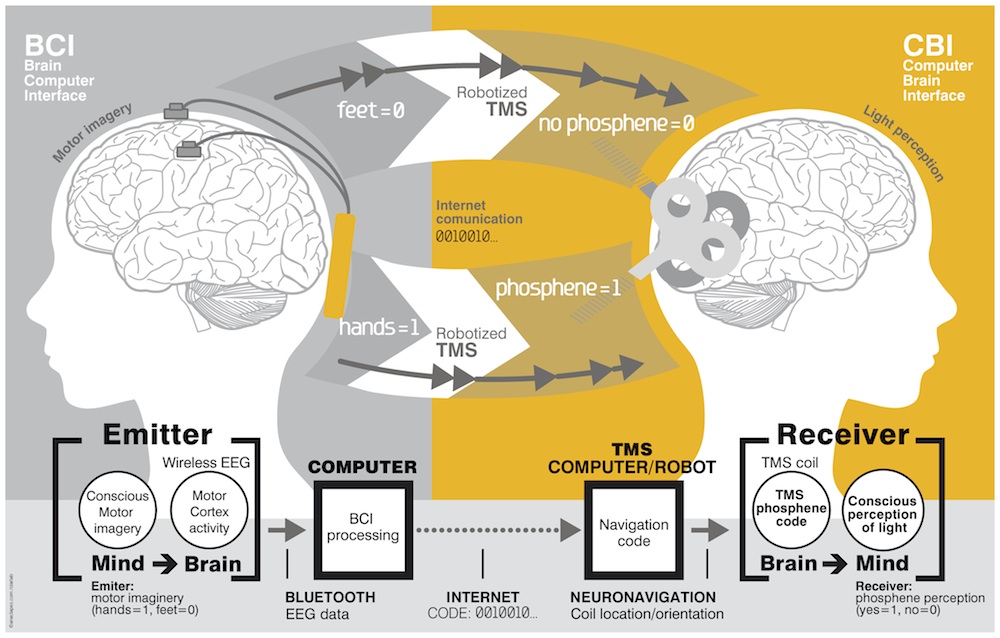Mind Messaging: Thoughts Transmitted by Brain-to-Brain Link

In an experiment that sounds more like science fiction than reality, two humans were able to send greetings to each other using only a digital connection linking their brains.
Using noninvasive means, researchers made brain recordings of a person in India thinking the words "hola" and "ciao," and then decoded and emailed the messages to France, where a machine converted the words into brain stimulation in another person, who perceived the signals as flashes of light. From the sequence of flashes, the French recipient was able to successfully interpret the greetings, according to a new study published today (Sept. 5) in the journal PLOS ONE. [Inside the Brain: A Photo Journey Through Time]
The researchers wanted to know if it is possible for two people to communicate by reading out the brain activity of one person and injecting that activity into a second person.
"Could we develop an experiment that would bypass the talking or typing part of [the] Internet and establish direct brain-to-brain communication between subjects located far away from each other, in India and France?" co-author Dr. Alvaro Pascual-Leone said in a statement. Pascual-Leone is a neurologist at Beth Israel Deaconess Medical Center in Boston, and a professor at Harvard Medical School, in Cambridge, Massachusetts.
To answer that question, Pascual-Leone and his colleagues at Starlab Barcelona, in Spain, and Axilum Robotics, in Strasbourg, France, turned to several widely used brain technologies.
Electroencephalogram, or EEG, recordings are taken by placing a cap of electrodes on a person's scalp, and recording the electrical activity of large regions of the brain's cortex. Previous studies have recorded EEG from a person thinking about an action, such as moving his or her arm, while a computer translates the signal into an output used to move a robotic exoskeleton or drive a wheelchair.
In other studies, a method called transcranial magnetic stimulation (TMS) has been used to stimulate parts of the brain by applying tiny electrical currents to the scalp. This causes the neurons in a certain area to fire. For example, TMS can make a person's muscles twitch or can produce flashes of light in his or her visual field.
Get the world’s most fascinating discoveries delivered straight to your inbox.
In the current study, the researchers linked these two processes, EEG recording and TMS. Four healthy volunteers took part in the mind-messaging experiment. One person, (the word sender) was hooked up to an EEG-based brain-computer interface; the other three people (the word recipients) received the messages in the form of TMS, and had to interpret the words based on the flashes they saw.
Using the system, the message sender, in India, transmitted the words "hola" (Spanish for "hello") and "Ciao" (Italian for "hello"/"goodbye") to the message recipients in France, located 5,000 miles (8,000 kilometers) away. All three recipients correctly translated the message, the researchers said.
In a second experiment, with volunteers in Spain and France, the total error rate for message transmission was 15 percent, and more of the error came from decoding the words than from encoding them, the researchers said.
The findings show it is possible to transmit a thought (albeit a very basic one) from one person to another without requiring the transmitter to speak or write, the researchers said.
"We believe these experiments represent an important first step in exploring the feasibility of complementing or bypassing traditional language-based or motor-based communication," Pascual-Leone said.
But the researchers stop short of calling it telepathy. The dictionary defines telepathy as communicating thoughts directly from one mind to another without using words or signals, but most scientists probably have something more sophisticated in mind than producing a light flash that means "hello."
Scientists previously demonstrated a human brain-to-brain connection that allowed one person to transmit a command to move another person's finger. And other experiments have demonstrated a kind of brain-to-brain connection between two rats and between two monkeys. Still, the technology remains in its early stages, most experts agree.
Follow Tanya Lewis on Twitter and Google+. Follow us @livescience, Facebook & Google+. Original article on Live Science.


